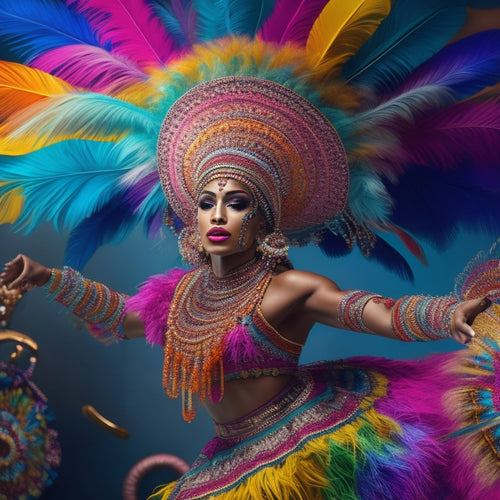
Unveiling the Dance-Theatre Connection: Mind Mapping Insights
Share
Mind mapping is a valuable tool for dancers and theatre practitioners, offering a visual framework to organize thoughts, enhance performance, and explore the intricate connections between movement, narrative, and emotional expression. By applying mind mapping techniques, dancers can conduct movement analysis, facilitate improvisation, and visualize physical and theatrical aspects of their art. This integrated approach enables deeper storytelling, increased artistic clarity, and a more profound understanding of the emotional intensity and complexity conveyed through body language. As we examine the intersection of dance and theatre, we uncover new dimensions of creative expression, and a richer understanding of the narrative unfolds.
Key Takeaways
• Mind mapping enables dancers to visualize and analyze physical and theatrical aspects of performance, enhancing overall performance quality.
• It facilitates improvisation and exploration of new possibilities, breaking down complex movements for improvement and refining artistic expression.
• By mapping relationships between movement, emotion, and narrative, dancers can convey complex narratives and emotional depth in their performances.
• Mind mapping helps dancers develop a deeper understanding of body language, which is crucial for conveying emotions and intentions in performances.
• Through mind mapping, dancers can uncover new ideas and connections, refining their artistic vision and creating impactful performances.
Mind Mapping for Dancers
As dancers seek to refine their craft, mind mapping emerges as a valuable tool for organizing thoughts, exploring creativity, and enhancing performance. This tool allows them to visualize and connect the physical and theatrical aspects of their art.
Through mind mapping, dancers can conduct movement analysis, breaking down complex movements into manageable components, and identify areas for improvement. This visual representation of their thoughts also facilitates improvisation techniques, enabling dancers to explore new possibilities and make connections between seemingly disparate elements.
Visualizing the Dance-Theatre Link
One pivotal aspect of dance-theatre connection lies in the ability to visualize the intricate relationships between physical movement and theatrical expression. This fusion of dance and theatre enables artists to explore new dimensions of creative expression. By mapping the connections between movement, emotion, and narrative, dancers can discover new levels of artistic expression.
Here are three key benefits of visualizing the dance-theatre link:
-
Enhanced creative exploration: Mind mapping allows dancers to explore new ideas and connections, fostering innovative artistic expression.
-
Deeper storytelling: Visualizing the dance-theatre link enables dancers to convey complex narratives and emotional depth, engaging audiences on a deeper level.
-
Increased artistic clarity: By mapping the relationships between movement and theatrical expression, dancers can refine their artistic vision, resulting in more cohesive and impactful performances.
Body Language in Performance
In performance, body language transcends verbal communication, conveying emotions, intentions, and narrative arcs through subtle yet powerful physical cues.
Non-verbal communication through body language is vital in dance-theatre performances, as it enables the audience to interpret and connect with the narrative on a deeper level.
Expressive movement and physical storytelling are pivotal elements in conveying the emotional intensity and complexity of a performance.
The way a performer carries themselves, uses gestures, and occupies space can greatly impact the audience's understanding of the narrative.
Effective body language can elevate the performance dynamics, creating a more immersive experience for the audience.
Frequently Asked Questions
How Does Physical Theatre Influence Contemporary Dance Performances?
Physical theatre greatly influences contemporary dance performances by incorporating kinesthetic storytelling and embodied narratives, allowing dancers to convey complex emotions and themes through dynamic, physically expressive movements that transcend verbal language.
What Role Does Improvisation Play in Physical Theatre Techniques?
In physical theatre, improvisation enables Spontaneous Expression, allowing performers to tap into embodied cognition, fostering a deeper connection between body and mind, and unleashing creative potential through unscripted, intuitive movements.
Can Physical Theatre Be Used in Non-Traditional Performance Spaces?
"Breaking free from traditional constraints, physical theatre can thrive in non-traditional performance spaces, leveraging site exploration and environmental staging to craft immersive experiences that blur boundaries and redefine the performer-audience dynamic."
How Does Physical Theatre Intersect With Other Art Forms Like Music?
Physical theatre intersects with music through rhythmic storytelling, where bodily expression harmonizes with sonic landscapes, creating a symphony of movement and sound that transcends traditional boundaries, fostering a dynamic interplay of art forms.
Are There Cultural Limitations to the Application of Physical Theatre?
The cultural limitations of physical theatre's application arise from cultural barriers and artistic constraints, which can restrict its adoption and expression in certain societies, highlighting the need for nuanced understanding and sensitivity in its cross-cultural application.
Related Posts
-

Why Stunning Dance Makeup Matters in Photography
When you're capturing the dynamic energy of dance in a single frame, stunning dance makeup isn't just a nicety, it's ...
-

Why Digital Solutions Are a Game-Changer
By integrating digital solutions into your operations, you can revolutionize your workflows, discover new revenue str...
-

Moo! Unveiling Latin Dance Culture Sensation
Latin dance culture is a vibrant phenomenon that embodies the essence of identity, community, and self-expression, re...


